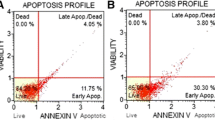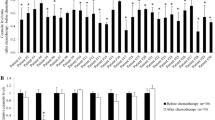Abstract
Purpose
Ceramide is glycosylated to glucosylceramide or lactosylceramide, and this glycosylation is a novel multidrug-resistance (MDR) mechanism. In this work, a short-chain ceramide (C6), lactosylceramide (LacCer), and an inhibitor of ceramide glycosylation (d-threo-1-phenyl-2-decanoylamino-3-1-propanol, PDMP) were evaluated on the proliferation of cervical cancer cells. The participation of glucosylceramide synthase (GCS), P-glycoprotein (P-gp), and multidrug-resistance gene-1 (MDR-1) in the resistance to the antiproliferative effect induced by C6 was also evaluated.
Methods
Cell proliferation was determined by crystal violet staining. GCS and MDR-1 mRNA expression was evaluated by real-time RT-PCR assay. GCS and P-gp protein expressions, as well as Rhodamine 123 uptake, which is a functional test for P-gp efflux activity, were determined by flow cytometry.
Results
C6 inhibited proliferation of CaLo and CasKi cells with an IC50 of 2.5 μM; however, 50 % proliferation of ViBo cells was inhibited with 10 μM. LacCer increased the proliferation of all cells. When cells were treated with PDMP plus C6, no additional effect on antiproliferation induced by C6 was observed in CaLo and CasKi cells; however, proliferation diminished in comparison with C6 alone in ViBo cells. C6 increased GCS and MDR-1 expression in all cells, as well as P-gp expression in CasKi cells.
Conclusions
Cells that have more capacity to glycosylate ceramide and express a higher level of GCS, MDR-1, and P-gp, are more resistant to the antiproliferative effect induced by C6.






Similar content being viewed by others
Abbreviations
- C6:
-
N-hexanoyl-d-sphingosine
- GlcCer:
-
Glucosylceramide
- MDR:
-
Multidrug resistance
- MDR-1:
-
Multidrug-resistance gene-1
- GCS:
-
Glucosylceramide synthase
- P-gp:
-
P-glycoprotein
- HPV:
-
Human papillomavirus
- LacCer:
-
Lactosylceramide
- PDMP:
-
d-Threo-1-phenyl-2-decanoylamino-3-morpholino-1-propanol
References
Carpinteiro A, Dumitru C, Schenck M et al (2008) Ceramide-induced cell death in malignant cells. Cancer Lett 264:1–10
Radin NS (2001) Killing cancer cells by poly-drug elevation of ceramide levels. A hypothesis whose time has come? Eur J Biochem 268:193–204
Sietsma H, Veldman RJ, Kok JW (2001) The involvement of sphingolipids in multidrug resistance. J Membr Biol 181:153–162
Lavie Y, Cao H, Bursten SL et al (1996) Accumulation of glucosylceramides in multidrug resistant cancer cells. J Biol Chem 271:19530–19536
Lucci A, Cho WI, Han TY (1998) Glucosylceramide: a marker for multiple drug resistant cancers. Anticancer Res 18:475–480
Gouazé-Andersson V, Yu JY, Kreitenberg AJ et al (2007) Ceramide and glucosylceramide upregulate expression of the multidrug resistance gene MDR1 in cancer cells. Biochim Biophys Acta 771:1407–1417
Palacio-Mejía LF, Rangel-Gómez G, Hernández-Avila M et al (2003) Cervical cancer, a disease of poverty: mortality differences between urban and rural areas in Mexico. Salud Publica Mex 45:S315–S325
López-Marure R, Gutiérrez G, Mendoza C et al (2002) Ceramide promotes the death of human cervical tumor cells in the absence of biochemical and morphological markers of apoptosis. Biochem Biophys Res Commun 293:1028–1036
Gutiérrez G, Mendoza C, Montaño LF et al (2007) Ceramide induces early and late apoptosis in human papilloma virus+ cervical cancer cells by inhibiting reactive oxygen species decay, diminishing the intracellular concentration of glutathione and increasing nuclear factor-kappaB translocation. Anticancer Drugs 18:149–159
Bernard B, Fest T, Prétet JL et al (2001) Staurosporine-induced apoptosis of HPV positive and negative human cervical cancer cells from different points in the cell cycle. Cell Death Differ 8:234–244
Monroy A, Rangel R, Rocha L et al (1992) Establecimiento de siete estirpes celulares provenientes de biopsias de cérvix normal y con cáncer cérvico-uterino y sus diferentes contenidos y localizaciones de desmogleína-1. Oncología 7:69–76
Kueng W, Silber E, Eppenberger U (1989) Quantification of cells cultured on 96-well plates. Anal Biochem 182:16–19
Rogalska A, Szwed M, Rychlik B (2014) The connection between the toxicity of anthracyclines and their ability to modulate the P-glycoprotein-mediated transport in A549, HepG2, and MCF-7 cells. Sci World J 19:819548
Liu YY, Han TY, Giuliano AE et al (2001) Ceramide glycosylation potentiates cellular multidrug resistance. FASEB J 15:719–730
Chatterjee S, Pandey A (2008) The Yin and Yang of lactosylceramide metabolism: implications in cell function. Biochim Biophys Acta 1780:370–382
Chatterjee S (1991) Lactosylceramide stimulates aortic smooth muscle cell proliferation. Biochem Biophys Res Commun 181:554–561
Liu YY, Gupta V, Patwardhan GA et al (2010) Glucosylceramide synthase upregulates MDR1 expression in the regulation of cancer drug resistance through cSrc and beta-catenin signaling. Mol Cancer 9:145
Weinstein RS, Kuszak JR, Kluskens LF et al (1990) P-glycoprotein in pathology: the multidrug resistance gene family in humans. Hum Pathol 21:34–48
Bellamy WT, Dalton WS, Dorr RT (1990) The clinical relevance of multidrug resistance. Cancer Invest 8:545–560
Ludescher C, Thaler J, Drach D et al (1992) Detection of activity of P-glycoprotein in human tumour samples using rhodamine 123. Br J Haematol 82:161–168
Kolesnick R, Golde D (1994) The sphingomyelin pathway in tumor necrosis factor and interleukin-1 signaling. Cell 77:325–328
Obeid LM, Hannun YA (1995) Ceramide: a stress signal and mediator of growth suppression and apoptosis. J Cell Biochem 58:191–198
Ohanian J, Ohanian V (2001) Sphingolipids in mammalian cell signalling. Cell Mol Life Sci 58:2053–2068
Ogretmen B, Hannun YA (2001) Updates on functions of ceramide in chemotherapy-induced cell death and in multidrug resistance. Drug Resist Updat 4:368–377
Liu YY, Han TY, Giuliano AE et al (1999) Expression of glucosylceramide synthase, converting ceramide to glucosylceramide, confers adriamycin resistance in human breast cancer cells. J Biol Chem 274:1140–1146
Imgrund S, Hartmann D, Farwanah H et al (2009) Adult ceramide synthase 2 (CERS2)-deficient mice exhibit myelin sheath defects, cerebellar degeneration, and hepatocarcinomas. J Biol Chem 284:33549–33560
Friedrich RE, Punke C, Reymann A (2004) Expression of multi-drug resistance genes (mdr1, mrp1, bcrp) in primary oral squamous cell carcinoma. In Vivo 18:133–147
Mu H, Wang X, Wang H et al (2009) Lactosylceramide promotes cell migration and proliferation through activation of ERK1/2 in human aortic smooth muscle cells. Am J Physiol Heart Circ Physiol 297:H400–H408
Morjani H, Aouali N, Belhoussine R et al (2001) Elevation of glucosylceramide in multidrug-resistant cancer cells and accumulation in cytoplasmic droplets. Int J Cancer 94:57–65
Olshefski RS, Ladisch S (2001) Glucosylceramide synthase inhibition enhances vincristine-induced cytotoxicity. Int J Cancer 93:131–138
Sietsma H, Veldman RJ, Kolk D et al (2000) 1-phenyl-2-decanoylamino-3-morpholino-1-propanol chemosensitizers neuroblastoma cells for taxol and vincristine. Clin Cancer Res 6:942–948
Shabbits JA, Mayer LD (2002) P-glycoprotein modulates ceramide-mediated sensitivity of human breast cancer cells to tubulin-binding anticancer drugs. Mol Cancer Ther 1:205–213
Senchenkov A, Litvak DA, Cabot MC (2001) Targeting ceramide metabolism—a strategy for overcoming drug resistance. J Natl Cancer Inst 93:347–357
Veldman RJ, Klappe K, Hinrichs J et al (2002) Altered sphingolipid metabolism in multidrug-resistant ovarian cancer cells is due to uncoupling of glycolipid biosynthesis in the Golgi apparatus. FASEB J 16:1111–1113
Prinetti A, Basso L, Appierto V et al (2003) Altered sphingolipid metabolism in N-(4-hydroxyphenyl)-retinamide-resistant A2780 human ovarian carcinoma cells. J Biol Chem 278:5574–5583
Zhang X, Li J, Qiu Z et al (2009) Co-suppression of MDR1 (multidrug resistance 1) and GCS (glucosylceramide synthase) restores sensitivity to multidrug resistance breast cancer cells by RNA interference (RNAi). Cancer Biol Ther 8:1117–1121
Xie P, Shen YF, Shi YP et al (2008) Overexpression of glucosylceramide synthase in associated with multidrug resistance of leukemia cells. Leuk Res 32:475–480
Gouazé V, Liu YY, Prickett CS et al (2005) Glucosylceramide synthase blockade down-regulates P-glycoprotein and resensitizes multidrug-resistant breast cancer cells to anticancer drugs. Cancer Res 65:3861–3867
Sun YL, Zhou GY, Li KN et al (2006) Suppression of glucosylceramide synthase by RNA interference reverses multidrug resistance in human breast cancer cells. Neoplasma 53:1–8
Patwardhan GA, Zhang QJ, Yin D et al (2009) A new mixed-backbone oligonucleotide against glucosylceramide synthase sensitizes multidrug-resistant tumors to apoptosis. PLoS One 4:e6938
De Rosa MF, Sillence D, Ackerley C et al (2004) Role of multiple drug resistance protein 1 in neutral but not acidic glycosphingolipid biosynthesis. J Biol Chem 279:7867–7876
Chapman JV, Gouazé-Andersson V, Karimi R et al (2011) P-glycoprotein antagonists confer synergistic sensitivity to short-chain ceramide in human multidrug-resistant cancer cells. Exp Cell Res 317:1736–1745
Acknowledgments
We thank Dr. Brianne O’Leary for critical reading of the manuscript. This investigation was financially supported by the CONACyT, Project Number 182341.
Author information
Authors and Affiliations
Corresponding author
Rights and permissions
About this article
Cite this article
Gutiérrez-Iglesias, G., Hurtado, Y., Palma-Lara, I. et al. Resistance to the antiproliferative effect induced by a short-chain ceramide is associated with an increase of glucosylceramide synthase, P-glycoprotein, and multidrug-resistance gene-1 in cervical cancer cells. Cancer Chemother Pharmacol 74, 809–817 (2014). https://doi.org/10.1007/s00280-014-2552-3
Received:
Accepted:
Published:
Issue Date:
DOI: https://doi.org/10.1007/s00280-014-2552-3




